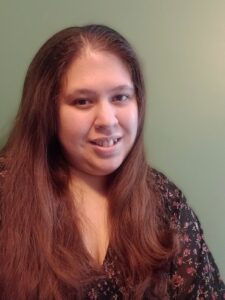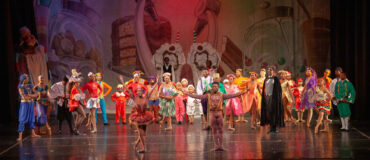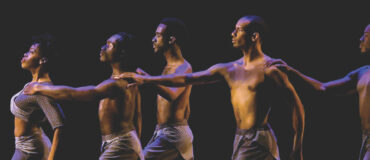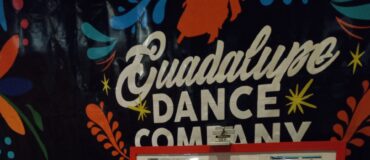By Tere Elizalde
Tere Elizalde is a 2022 Archiving and Preservation Fellow with Guadalupe Cultural Arts Center/Guadalupe Dance Company. Read more about the Fellowships here. This is the third part of Tere’s blog. Read the second part here.
September 26, 2022: Beyond the Archive’s Borders
It’s been another busy month at the Guadalupe Cultural Arts Center (GCAC), with lots of conversations about the archive, thinking about what comes after my Fellowship, and working with the collections in a new way.
I spent quite some time this month speaking with different members of the Guadalupe. First was a meeting to update them on my progress, to learn of future goals, and to get a better understanding of a critical part of the GCAC’s archive, their digital storage. After updating staff on my inventory work and preservation assessment and actions, staff realized that this work, such as the inventory, could be used in grant applications, as they know there are always costs to archival work. 
I was able to speak more with staff about digital preservation. In these conversations, I got a better understanding of the current state of the GCAC’s digital infrastructure, which will help me design procedures and policies relevant to the collection’s digital files, particularly for digital preservation. While most of my work this summer has been interacting with physical materials, a goal is to digitize them and make them accessible to the public. In addition, the center is actively creating born-digital content. Conversations focused on two areas, storage and access. I learned that who gets digital access to what and how that is accomplished is a challenge to resolve. In general, most of the content is not accessible by all staff despite interest in the files, and much is on hard drives, which presents issues when keeping files safe. While I’ve been discussing the concept of making copies of digital content and keeping these files in different locations, it can be challenging to implement and wrap one’s head around digital preservation.
One reason is that it is not easy to imagine the space needed for digital content when it is not easily visible like boxes and folders. When discussing the storage space, the GCAC staff had questions about what equipment should be used and how online options for preservation function. It is also difficult to imagine all the resources and costs to maintain and update digital assets to reduce the risk of obsolescence. This applies not just to computers or hard drives, but areas such as file formats, security, staff labor needed to interact and handle digital content, and so on. While it would be great to have a copy for safe-keeping, a copy to view, a copy to use for new works, and to always keep the highest quality versions, deciding on storage methods and designing a policy or a workflow that accounts for feasibility of the archive is still a work in progress.

David Gonzales and wife viewing a poster from the Guadalupe Dance Company’s collaboration with Los Lobos.
I also got a chance to speak with Dan Margolies, a historian working with the center who will be the main contact about the GCAC archive after my Fellowship. It was fantastic to speak with him in more detail about the project due to his experience in archiving and the organization. In particular, he is aware of the history of the organization, the importance of communities controlling their legacies, and what challenges lie ahead. The conversation was important in reiterating that this work will not end with what I do, but become a part of a longer project for the whole organization. It was also helpful to hear ideas about how to approach my work, not only thinking about what is possible right now, but considering standards to aim for. Although I have been focusing my work on what is feasible, information regarding archiving standards should still be shared with the GCAC, as it will familiarize the staff with the language for archival conversations in future phases.
This month I had several opportunities to speak with a previous staff member of the GCAC, David Gonzales, who worked with the GCAC for many years as a graphic designer and educator. On the day of his first visit, he brought a newspaper article of the debut performance of the Guadalupe Dance Company, found during his work organizing his personal archives. A copy of this would be exhibited in one of the events we were planning in early August. Not only did David have rich knowledge of the history of the GCAC, but also of the Westside neighborhood that the GCAC calls home. The organization has a rich history which is not widely known outside the area; hearing stories of how David developed his art and skills demonstrated to me how important organizations such the GCAC are in giving opportunities to share knowledge and cultivate a passion for the arts. It was also an opportunity to connect as people living in San Antonio. As I have been living in San Antonio throughout the summer, many of the street names and places I’ve seen and heard of are the same as those that David traversed throughout his life. Learning more about the places that still exist or once existed showed how critical it is to extend the reach of archiving beyond the archive’s borders.
All photos courtesy of the author.
 Tere Elizalde is pursuing a master’s degree in information science at the University of Michigan’s School of Information, focusing on Digital Archives, Library Science, and Preservation. Prior to studying archives, she obtained her MA in International and Regional Studies from the University of Michigan in 2021.
Tere Elizalde is pursuing a master’s degree in information science at the University of Michigan’s School of Information, focusing on Digital Archives, Library Science, and Preservation. Prior to studying archives, she obtained her MA in International and Regional Studies from the University of Michigan in 2021.
Drawn to how history impacts people’s way of interacting and understanding information, she sought out archives as a way to engage with underrepresented communities and increase their visibility and stories in collections to reshape societal narratives about history.
Currently working at the Bentley Historical Library as a Reference Assistant, she gets to experience and understand how various audiences interact with archives, and uses it to inform her archival practice.
Tere is looking forward to bringing her past and current experiences in research, reference, preservation, and community engagement to work alongside the Guadalupe Cultural Arts Center this summer to begin the process of creating a sustainable and community-accessible archive that features the center’s rich and cultural engagement with dance.
____
We accept submissions on topics relevant to the field: advocacy, artistic issues, arts policy, community building, development, employment, engagement, touring, and other topics that deal with the business of dance. We cannot publish criticism, single-company season announcements, and single-company or single artist profiles. Additionally, we welcome feedback on articles. If you have a topic that you would like to see addressed or feedback, please contact communications@danceusa.org.
Disclaimer: Opinions expressed in guest posts do not necessarily represent the viewpoints of Dance/USA.





